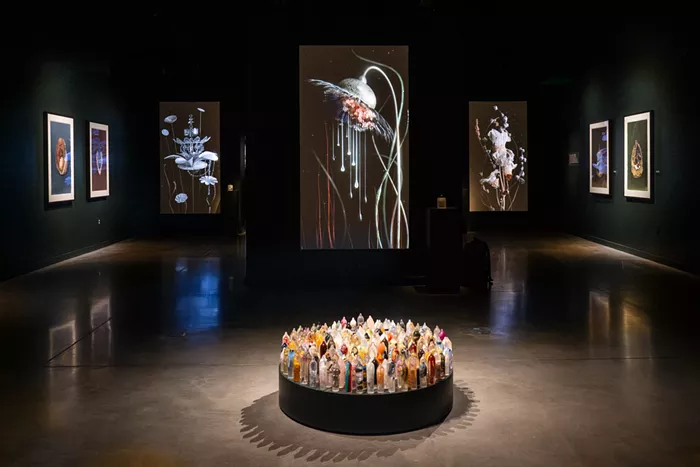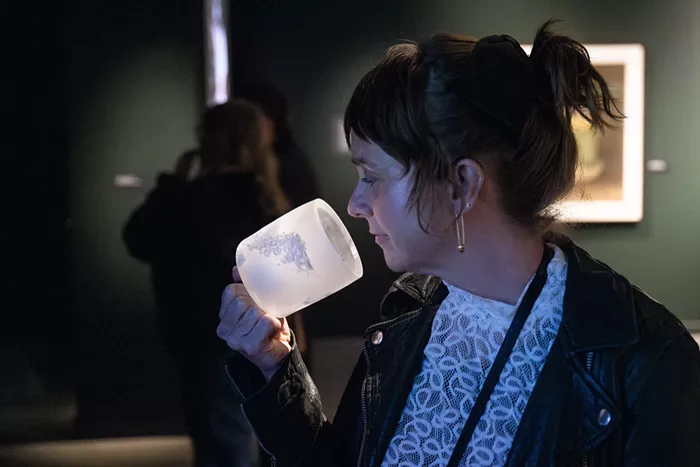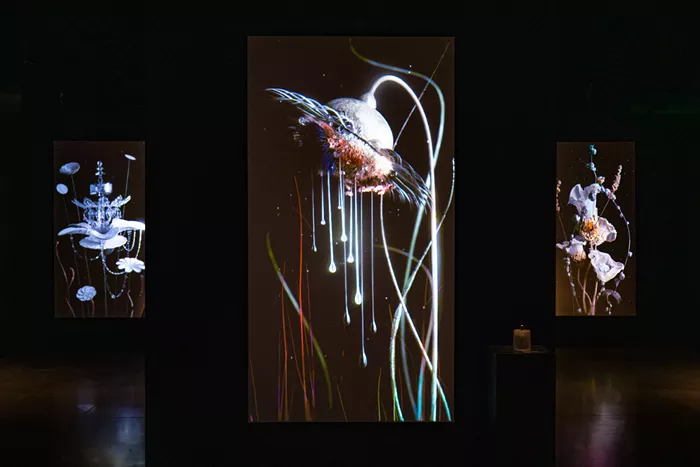If an ethereal falsetto singing in an invented language wafted into your ears someday during the last three many years, likelihood is good that it was Jónsi’s. However the Icelandic singer and multi-instrumentalist behind the post-rock band Sigur Rós can also be invested in one other immersive, ephemeral medium: He creates fragrance along with his sisters Lilja, Inga, and Sigurrós Birgisdóttir as Fischersund, an artwork collective primarily based in Reykjavík.
Fischersund: Fake Flora, the collective’s first exhibition, arrives at Seattle’s Nationwide Nordic Museum on the heels of FLÓÐ, Jónsi’s scented exhibition hosted by the museum in 2023. This present feels fully distinct, although. Fake Flora envelops the viewer—or experiencer, relatively—in a multisensory show of the chapters of human life by means of the lens of imagined vegetation, that are paired with scent blends and soundscapes.
Forward of the exhibit’s opening, I spoke with Jónsi, Lilja, Inga, and Nationwide Nordic Museum chief curator Leslie Anderson about scent mixing, botanical treatises, the local weather disaster, and their favourite Icelandic vegetation.

“The world we’re dwelling in—it’s typically so bleak. I believe it’s necessary to make some magic.” JIM BENNETT PHOTO BAKERY FOR NATIONAL NORDIC MUSEUM
Fake Flora is the primary exhibition by Fischersund as a collective. What sparked your loved ones’s curiosity in perfumery? How did that observe evolve into multimedia artwork?
Jónsi: I began perfuming round 15 years in the past.
Inga Birgisdóttir: He was all the time displaying us his creations, and we have been amazed, however he was by no means proud of something. Lastly, we form of bullied him into releasing one scent!
Lilja Birgisdóttir: We’re all artists—musicians, perfumers, visible artists, photographers—so it was all the time a dream for us to create one thing greater collectively. [Jónsi] had this home in downtown Reykjavík the place he’d had his personal studio, making music and perfumes. Then he moved his studio to LA, so it was empty. So we painted the partitions black, put some artwork on the partitions, had music enjoying, and that was about it. That’s how [our perfumery] began.
Did every of you’ve gotten particular roles within the creation of Fake Flora, or was it extra of a collaborative course of?
Jónsi: That is all collaborative, however we now have our personal strengths.
I’m curious how the sculptural, scented, graphic, and photographic parts in Fake Flora are introduced collectively. What can somebody anticipate after they stroll into the museum area?
Inga: The exhibition shares the life cycle of a flowering plant: germination, progress, flowering, seed formation, and seed dispersal. We’re form of…
Jónsi: Mirroring.
Inga: Yeah, mirroring that course of in human life: delivery, progress, adolescence, maturity, and dying. The flowers are categorized in these 5 totally different chapters all through the exhibition.
Lilja: You may anticipate to see some video works, hand-colored pictures, sculptures, music, and deconstructed scents. Every flower has its personal scent and soundscape.
Leslie Anderson: To situate this concept inside the context of artwork historical past and pure science, [we were] fascinated about this exhibition in relation to botanical treatises. These had so many various features, however they have been actually a solution to describe the pure world. Fake Flora is a intelligent response to that sort of textual content, which might bear lovely illustrations by artists but in addition comprise descriptions of vegetation and talk the expertise of being with that instance of vegetation to anybody on the earth. On this case, Fischersund takes it a lot additional as a result of you may scent the vegetation. You may hear them of their setting.

Fake Flora was impressed by the five hundred native plant species in Iceland, however the present invents new plant species. How does that strategy of invention work?
Jónsi: Icelandic vegetation was a place to begin, but it surely developed from our creativeness, our feelings, our reminiscences.
Do any of you’ve gotten a favourite Icelandic native plant?
Jónsi: Fífa could be very cool. [Eriophorum angustifolium, common cottongrass.]
Inga: I additionally like Arctic root [Rhodiola rosea], which is sort of a super-plant. It’s actually good for you, good in your reminiscence. It smells actually candy.
Lilja: Chervil [Anthriscus cerefolium]—an Icelandic plant with a licorice scent. We now have it in our teas and within the fragrance.
Jónsi: We use a number of Icelandic pine in our perfumes, too.

Curating a present with scent parts seems like a novel problem. Leslie, I’m curious the way you combine scent right into a public area.
Leslie: There are prolonged conversations that we now have to have on workers—considerations about our HVAC system, making certain that the scent is impactful and soliciting the response that artists need, however with nothing dispersed within the ambiance that might compromise different objects within the museum. It takes a number of inventive problem-solving to find out how we will be certain that the viewer is knowing the work in its entirety by means of their nostril, whereas nonetheless working inside museum skilled practices.
Scent in exhibitions is a solution to elicit an emotional response, to evoke reminiscence. I believe that museums must encourage individuals to spend time pondering deeply about and responding to artworks. That is a crucial creative technique right here. It’s not too dissimilar from Bernini’s Seventeenth-century fusions of the visible—portray, sculpture, structure—to convey necessary factors, or, within the nineteenth century, Wagner’s thought of a “complete murals,” or Gesamtkunstwerk. It is a human translation of those concepts wedded with forward-thinking creative practices to get a full, emotional, bodily response from the viewer.
It looks like scent is having a second in modern artwork. I do know FLÓÐ was an enormous success; there was a 12.5% improve in museum membership throughout that point. What’s drawing artists and guests towards scent as a medium and an expertise?
Leslie: Popping out of the pandemic, [viewers were] trying to find experiences that transported them. We’re extra cognizant of how we spend our time, and we would like these moments to be very impactful. I additionally noticed FLÓÐ as a really social exhibition. Folks spent hours by themselves within the area, however additionally they appreciated it in teams and talked about it. It permits viewers to expertise and share in a manner that they weren’t in a position to in lockdown.

I do know seaweed was harvested from the Pacific and North Atlantic Oceans for FLÓÐ, Jónsi. Are there any anchor or major scents in Fake Flora?
Jónsi: We have been largely excited concerning the 5 totally different levels. It’s totally different from FLÓÐ, which centered on one scent—that is various.
Lilja: For our “delivery” scent, we have been fascinated about what scents we join with that interval—breast milk, pores and skin, clear garments. It’s nuanced as a result of we’re mirroring the human lifespan—like in childhood, you’ve gotten the scent of grass-stained pants and sweet. Within the exhibition, the flowers themselves are hinting at what you’re smelling.
On the Fischersund web site, I seen how poetically scent is written about—like No. 23 Perfume, which is rooted in Jónsi’s reminiscences of working by the harbor along with his father. That connection between scent and storytelling appears highly effective. It’s cool to listen to that you simply’re mixing scents which are each surprising and acquainted, like grass and pores and skin.
Lilja: Scent is a common language. Grass smells the identical anyplace on the earth, you recognize? That’s the attractive factor about scent…
Jónsi: It’s a connector.

Does this work really feel linked to local weather change? I’m fascinated about vegetation rising and dying and disappearing. I’m fascinated about the ephemerality of our reminiscences. Scent, as you simply stated, is a common language—and the state of the local weather is a common disaster. Does that really feel resonant?
Inga: Sure—we’re coping with that daily. That’s our actuality proper now. A few of these reminiscences or shared experiences that we’re working with are disappearing, too.
Lilja: For instance, we took previous books and distilled them right into a scent. It was attention-grabbing speaking to younger individuals about it, [for whom] every thing occurs on their screens. They didn’t have these connections, and their houses weren’t full of books. That’s additionally one thing that’s altering—bodily versus digital.
Leslie: Scent is such an efficient software in conjuring reminiscences. In FLÓÐ, a few of the customer responses that I felt have been strongest have been people who mirrored on rising flood waters and the local weather disaster. However different individuals talked about how the scents introduced them again to their youth in Norway. The present was interpreted in another way by each single particular person. To your query on local weather change and the extinction of vegetation, I believe that this exhibition follows together with botanical treatises and taxonomies, but it surely’s for the Anthropocene period. It’s memorializing, regardless that these are “fake” flora. It memorializes vegetation that we’ll lose due to human influence.
The method of imagining new plant species makes me consider your observe of singing in your invented Hopelandic language, Jónsi. What feels necessary about imagining one thing new in your work?
Jónsi: I believe doing one thing new and exploring is necessary to all of us.
Inga: And naturally, the world we’re dwelling in—it’s typically so bleak. I believe it’s necessary to make some magic.
You will have scented live shows deliberate with Sin Fang and Kjartan Holm as opening receptions for Fake Flora. Do you see any similarities or variations between the perfumery course of and the music-making course of?
Jónsi: They’re linked. Making music could be very… musical. [laughs] However fragrance is [more of] a silent course of.
Inga: Each are very layered. These layers make it juicy.
Jónsi: Each are invisible and summary however nonetheless resonate not directly with all people. So it’s form of wonderful. It’s magic.
Lilja: Yeah, it’s magic. If you use your eyes, you’re so used to being vital. However there’s one thing about music and scent that goes previous these partitions. You both like a scent otherwise you hate a scent. It’s the identical in music.
Fischersund: Fake Flora can be put in on the Nationwide Nordic Museum by means of January 26, 2025.

